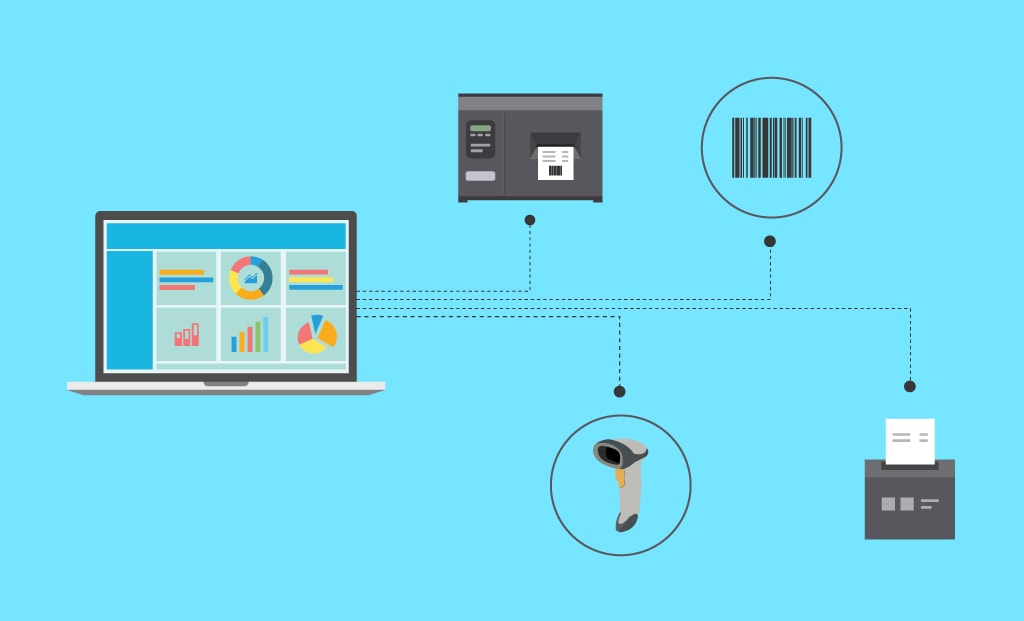When was the last time you noticed or paid attention to a bar code label on a product or a package? For a layman, it is an insignificant thing that is useful only at the cash counter of a supermarket where it is scanned for billing of a particular product. Thereafter, it is of no use to the person who has purchased the product, but for a manufacturer, bar code labeling along with an ERP software plays a vital role in their day to day operations.
Role of Labeling in Manufacturing
As mentioned earlier, bar code labeling plays a major role in manufacturing and retail enterprises. Bar code technology automates crucial workflows such as supply chain management, materials management, production management and shipping. It enables enterprises to collect real-time data pertaining to goods movement within their premises, and at the time of goods receiving & shipping.
With bar-code labeling they can identify a particular raw material batch, semi-finished or work in progress goods, finished product, spare parts, tools, and production supplies. They can keep track of raw materials right from its procurement till its assimilated into the final product and shipped to the customer.
Apart from aiding real-time material tracking and inventory efficiency, bar code labeling also drives quality compliance. With bar code data, manufacturers can easily and quickly point out to a defective batch of raw materials, semi-finished goods or final product. This reduces the possibility of a defective product being manufactured and time to recall in case of finished goods already shipped to the customer.
How does Bar Code Labeling work?
Bar code labeling requires the following,
An ERP software is a must for every manufacturer. Most ERPs today, have in built capabilities of integrating with third party manufacturing applications. Bar code applications such as Zebra, Bartender, Wasp and even native applications can be easily integrated with an ERP.
Bar Code Printer
There are specialized printers for printing bar code labels. These can be thermal printers, dot matrix, ink jet, or laser printers. Manufacturers prefer thermal printers that can print high quality bar codes resistant to heat, chemicals, and overall manufacturing environment. The other printer types are more preferred by cost conscious or small-scale manufacturers.
Bar Code Material
A printing material is as important as the printer. There are various materials such as paper, polyester, acrylic etc. For longevity, manufacturers prefer acrylics or polyester depending on the material the bar code will be applied.
Bar Code Scanner
There are wired and wireless bar code scanners. In manufacturing, wireless scanners play a major role as personnel can identify materials or scan incoming goods from anywhere, anytime. Wired scanners are mostly used at billing counters of a retail store.
Labeling Capabilities in ERP
An ERP software has in built integration capabilities to work with bar code software, printing devices and bar code scanners (portable or connected). The bar code labels are generated using an in-built report writer or with the help of third-party bar code applications integrated with it.
During goods receipt, personnel can use portable printers to quickly print bar code labels and apply them on goods such as, finished products, raw materials, semi-finished goods, supplies, tools etc. The goods are then immediately scanned using portable (wireless) or wired bar code scanners that sends scan information to the ERP. The data is stored in the centralized database of the ERP. This ensures that enterprises have a ready count of how much materials they have in hand and enables them to seamlessly schedule jobs, and accurately arrive at job costs.
Bar code software such as Zebra, Bartender and Wasp etc. offer bar code templates that can be instantly applied to create 1D and 2D bar codes. These templates can also be customized based on a customer preference or as per the industry compliance standards.
Benefits of Bar-code capable ERP
An ERP and Bar code integration increases material handling, inventory management, and warehouse management efficiency for manufacturers.
Inventory Management & Traceability
Incoming goods from suppliers and third-party vendors can be instantly tagged with bar code labels for easy identification. In the absence of bar code technology, this identification tagging process would have taken a long time with the presence of personnel and a lot of papers. Tagging them with bar code ensures that all incoming goods data is entered into the system and can be traced along their entire journey within the production floor.
Any product can be searched and tracked instantly thereby reducing response time, improving material trace-ability, decreasing production interruption and delays. Bin management is a breeze as the manufacturer knows where to find a particular product. Inventory counting can be easily conducted at a click of a button within the ERP rather than having to resort to physical counts.
Shipments can be tracked till they reach customers, thereby improving shipping efficiency and customer satisfaction. Real-time data capture improves warehouse management, stock management and reduces labor, storage and movement costs.
Speed of Operations & Efficiency
Operational speed increases to a great extent as manual methods of inventory recording and tracking are eliminated. Production demand is met most of the time, as inventory data is available in real-time and stockouts are handled more efficiently.
Good quality software and bar code devices (scanners & printers) ensure that scope of errors is very minimal that can usually occur while printing bar code labels and during scanning.
Quality compliance improves thereby enabling enterprises to meet stringent industry standards. Inventory cost and labor costs are reduced to a great extent, production efficiency is improved, interruptions & delays decrease and overall profitability improves.
Mobility & Time Management
Time is the biggest asset for any manufacturer and bar code technology helps them cut down time on variety of activities. Manual tasks such as data input of each material batch, supplies and tools using paper, pencil or spreadsheets are eliminated completely. Sifting through tons of paperwork to determine the exact inventory count or finding a defective batch becomes a thing of the past.
Bar code technology brings enhanced mobility and flexibility for manufacturers. Tagging or identifying materials anywhere on the production floor, anytime from hand held bar code scanners and printers allows manufacturers to save lot of man hours and effort.
Conclusions
Bar code technology is more than a necessity for manufacturers, retailers and distributors as it helps them reduce human errors, automate workflows, enhance productivity and bring down costs.
OmegaCube ERP has in-built capabilities to integrate with Bar code applications, scanning devices and printers. Check our Integration page for more details.






